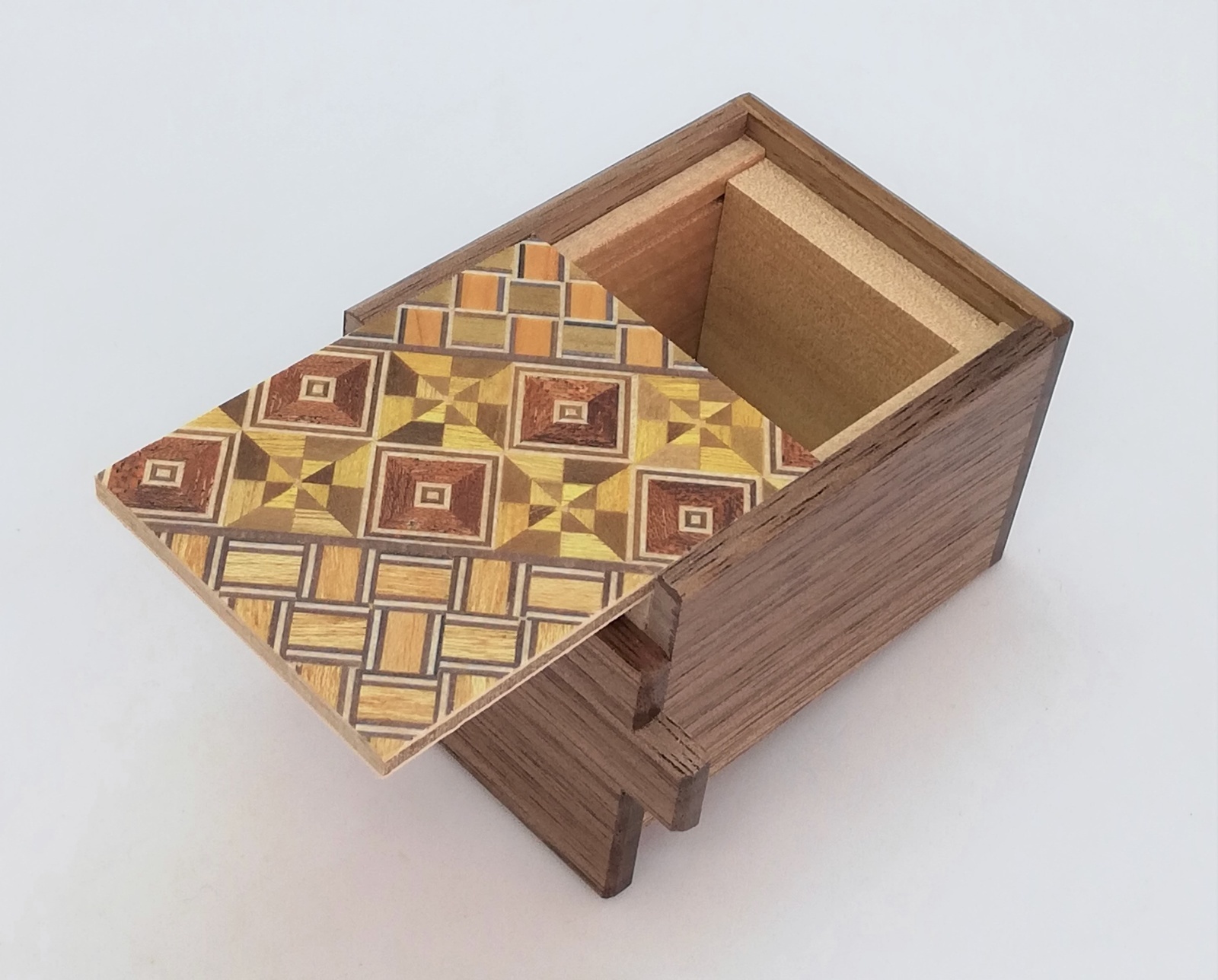Parts of himitsu-bako
Today is another extremely hot day, and it looks like our area might break the record for the highest temperature again. It’s already over 39°C and getting close to 40°C. This morning, I focused on tasks that require woodworking machines, and in the afternoon, I worked on things like panel attachment and assembly — tasks that are less physically intense.
Several projects are moving forward at the same time. The 2-sun cube is in the painting stage and almost finished. The 3-sun 18-steps puzzle box was fully assembled today. And now, I’ve started the next project — 2-sun puzzle box. This time, it’s not the cube style but a regular 2-sun size, which I haven't made in a while. The order came from an overseas shop. They've requested 40 pieces, but I plan to make 50 in total, including some for my own stock.
Today, I began by preparing the materials — cutting them down to the right sizes — and working on the axis panels and structural side panels.
I'd like to take a moment to talk briefly about the materials used in Himitsu-bako — not the types of wood, but the sizes of the boards used for each part. Because of their structure, himitsu-bako require boards of many different thicknesses and dimensions for each specific part. This is one of the things that makes puzzle box making more complex and time-consuming compared to regular boxes.
Just off the top of my head, I can think of about seven types of materials needed:
Structural side panels (long sides), Axis, Aruki panels (moving panels), Top and bottom Aruki panels, Outer side panels, op and bottom panels and the“bocchi”(a small wooden parts of inside)
All of these need to be cut from solid wood with different sizes and thicknesses. Depending on the box, I sometimes use plywood for the top and bottom panels. In addition to all that, there are also small internal parts that need to be prepared.
For just one type of box, I have to prepare enough of each of these materials for the number of boxes I plan to make.
When I first started making himitsu-bako (which was quite a long time ago), I was honestly surprised by how many different materials were needed. Before that, I was mainly making regular boxes, trays, or pen stands, which usually only required two or three kinds of materials. For example, a tray could be made from one type of wood for the edges and a piece of plywood for the bottom. Even a lidded box could be made with just three kinds: side panels, a top panel, and a plywood base.
Now I’m completely used to it, but back then, just preparing the materials was a bit overwhelming. You might think it would be easier and more efficient to use the same thickness of wood for all parts, but if you do that, the final puzzle box ends up looking awkward and doesn’t work smoothly. That’s why I believe that each part of the box should have its own proper thickness and size, there’s a reason behind every detail.
Several projects are moving forward at the same time. The 2-sun cube is in the painting stage and almost finished. The 3-sun 18-steps puzzle box was fully assembled today. And now, I’ve started the next project — 2-sun puzzle box. This time, it’s not the cube style but a regular 2-sun size, which I haven't made in a while. The order came from an overseas shop. They've requested 40 pieces, but I plan to make 50 in total, including some for my own stock.
Today, I began by preparing the materials — cutting them down to the right sizes — and working on the axis panels and structural side panels.
I'd like to take a moment to talk briefly about the materials used in Himitsu-bako — not the types of wood, but the sizes of the boards used for each part. Because of their structure, himitsu-bako require boards of many different thicknesses and dimensions for each specific part. This is one of the things that makes puzzle box making more complex and time-consuming compared to regular boxes.
Just off the top of my head, I can think of about seven types of materials needed:
Structural side panels (long sides), Axis, Aruki panels (moving panels), Top and bottom Aruki panels, Outer side panels, op and bottom panels and the“bocchi”(a small wooden parts of inside)
All of these need to be cut from solid wood with different sizes and thicknesses. Depending on the box, I sometimes use plywood for the top and bottom panels. In addition to all that, there are also small internal parts that need to be prepared.
For just one type of box, I have to prepare enough of each of these materials for the number of boxes I plan to make.
When I first started making himitsu-bako (which was quite a long time ago), I was honestly surprised by how many different materials were needed. Before that, I was mainly making regular boxes, trays, or pen stands, which usually only required two or three kinds of materials. For example, a tray could be made from one type of wood for the edges and a piece of plywood for the bottom. Even a lidded box could be made with just three kinds: side panels, a top panel, and a plywood base.
Now I’m completely used to it, but back then, just preparing the materials was a bit overwhelming. You might think it would be easier and more efficient to use the same thickness of wood for all parts, but if you do that, the final puzzle box ends up looking awkward and doesn’t work smoothly. That’s why I believe that each part of the box should have its own proper thickness and size, there’s a reason behind every detail.
